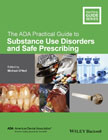
The ADA Practical Guide to Substance Use Disorders and Safe Prescribing
O?Neill, Michael
Dentists have been inundated by patients with an array ofcomplicated medical conditions and pain/sedation management issues.This is in addition to a variety of legal regulations dentists mustfollow regarding the storage and recordkeeping of controlledsubstances. Avoid unknowingly putting your practice at risk bybecoming victim to a scam or violating a recordkeeping requirementwith The ADA Practical Guide to Substance Use Disorders and SafePrescribing. This Practical Guide is ideal for dentists and staff asthey navigate: Detecting and deterring substance use disorders(SUD) and drug diversion in the dental office (drug–seekingpatients) Prescribing complexities Treating patients with SUD and complex analgesic andsedation (pain/sedation management) needs and the best use ofsedation anxiety medication Interviewing and counselling options for SUD Federal drug regulationsCommonly used illicit, prescription, and over–the–counter drugs, aswell as alcohol and tobacco, are also covered. Special features include: Clinical tools proven to aid in the identification,interviewing, intervention, referral and treatment of SUD Basic elements of SUD, acute pain/sedation management,and drug diversion Summary of evidence–based literature that supportswhat, when and how to prescribe controlled substances to patientswith SUD Discussion of key federal controlled substanceregulations that frequently impact dental practitioners Checklists to help prevent drug diversion in dentalpractices Chapter on impaired dental professionals Case studies that examine safe prescribing and duediligence INDICE: Contributors xxx.Preface xxx.Acknowledgements xxx.1. Substance Use Disorders, Drug Diversion and PainManagement– The Scope of the ProblemMichael O Neil.1. Introduction.2. Definitions.3. Overview: SUD, Drug Misuse, Drug diversion and PainManagement.a. SUD.b. Medication Misuse.c. Alcoholism.d. Drug Diversion.e. Pain Management in Dentistry.4. Understanding the Cultures of SUD, Drug Misuse and DrugDiversion.a. Sharing Culture.b. Income Driven Culture.c. Substance Abuse Culture.d. Addiction Culture.e. Combination of Cultures.5. Summary.2. Understanding the Disease of Substance Use DisorderCarl Rollynn Sullivan and James Berry.1. Introduction.2. Definitions.3. Epidemiology: Drug / Alcohol.4. Pathophysiology.5. Signs /Symptoms/ Behavior.a. alcohol.b. benzodiazepines.c. opioids.d. stimulants.e. cannabis.f. nicotine.g. hallucinogens, designer drugs, inhalants.6. Treatment methods.a. Behavior modification and counseling.1. Motivational Interviewing.2. CBT.3. Contingency Management.4. AA / 12 steps.b. Pharmacological management.(Agents, pharmacology, pharmacokinetics, dosing, adverseeffects, contraindications, drug selection, goals, duration oftreatment, monitoring, outcome documentation).7. Summary.3. Principles of Pain Management in DentistryPaul Moore and Elliot Hersh.1. Introduction.2. Definitions.3. Neurophysiology and Neuroanatomy of Acute InflammatoryPain.4. Agents, pharmacology, pharmacokinetics, dosing, adverseeffects, contraindications, Drug selection, duration of treatment,monitoring, documentation.a. nonopioid.b. opioid.5. Medication Assisted Therapies for Drug Dependence.6. Adjunctive Drugs.7. Preemptive Analgesics.8. Corticosteroids.9. Guidelines to Analgesic Therapy.10. Summary.5. Special populations (renal insufficiency, coagulopathies,etc.).6. Safe prescribing considerations.7. Summary.4. Special Pain Management Considerations.Michael O Neil.1. Introduction.2. Definitions.3. Interviewing the Patient: Establishing Goals of Treatment.4. Pharmacological Treatment of Opioid Addiction / AcutePain.a. methadone.b. buprenorphine.c. naltrexone.5. Acute pain management patients with chronic nonmalignantpain.6. Summary.5. Sedation and AnxiolysisMatthew Cooke.1. Introduction.2. Definitions.3. Spectrum of Anesthesia and Sedation.4. Preoperative evaluation.5. Physical Status Classification.6. Sedation.7. Medications in Patients with SUD.a. nitrous oxide.b. benzodiazepines.c. opioids.d. ketamine.e. propofol.f. alpha–agonist.g. local anesthetics.8. Balance Anesthesia.9. Monitoring and documentation.10. Moderate conscious sedation.11. Deep sedation.12. Emergencies.13. Special considerations.14. Summary.6. Common Substances and Medications of AbuseGeorge Raymond and William Maloney.1. Introduction.2. Definitions.3. Signs and symptoms.4. (drugs/chemicals, pharmacology, effects, routes, dentalcharacteristics/patho, disease specific complications).a. Illicit drugs.1. Stimulants Methamphetamine, Cocaine.2. Hallucinogens.3. Opioids.4. Inhalants.5. CNS depressants.6. Marijuana.5. Prescription Drugs.1. Opioids.2. Stimulants.3. CNS depressants.4. Antipsychotics.5. Muscle relaxants.6. Anticonvulsants.7. Other Agents.6. OTCs.7. Summary.7. Nicotine and tobacco CessationFrank Vitale and Amanda Eades.1. Introduction.2. Definitions.3. Epidemiology –cigarettes, cigars, pipes, water pipes, chewingtobacco, dip/snuff.4. Oral effects of tobacco.5. Dental practitioner Management of Tobacco USE.a. Brief intervention.b. Low intensity.c. Moderate intensity.d. Spit tobacco interventions.6. Medication Management.a. Role of nicotine.b. NRT.c. Individual Agents.d. Non FDA approved treatments.7. Summary.8. Detection and Deterrence of Substance Use Disorder andDrug Diversion in Dental PracticeSarah Melton and Ralph Orr.1. Introduction.2. Definitions.3. Screening patients and referrals fortreatment/intervention.a. SBIRT.b. CAGE.c. NMASSIST.4. Schemes and scams.a. In office behaviors.b. Behavior prevention.c. Out of office behaviors.d. Dental practitioner Diversion.5. PDMP.a. Brief History of PDMPs.b. PDMP as a tool / general principles.c. Interpreting PDMP reports.d. Case.6. Drug disposal.7. Universal Safe prescribing practices.9. Summary.9. Dentist Interviewing and Counseling of Patients withSubstance Use Disorders and Dealing with Drug SeekingPatientsGeorge Raymond and William Maloney.1. Introduction.2. Definitions.3. Pre–interview considerations.4. Questions to ask.5. Interviewing / counseling.6. Screening tools.7. Documentation.8. Summary.10. Office Management of Controlled Substances and RecordKeepingCarlos Aquino.1. Introduction.2. Definitions.3. Federal and State Regulations.4. Common violations by dentist.a. Scope of practice.b. Record keeping.c. Storage.d. Record keeping.5. Record Keeping.a. Purchasing / storage /security.b. Drug disposal.6. Documentation.7. Surviving a Dental Board Inspection or DEA Audit.8. Due Diligence.9. Non–Controlled Substance Management.10. Summary.11. The Impaired Dental Health Professional and OfficeStaffWilliam Kane.1. Introduction.2. Definitions.3. Epidemiology of Substance Use Disorder in healthcare.4. Neurobiology.5. Stigma of Addiction.6. Risk Factors.7. Substances of Choice.8. Identification of the Impaired Professional.9. Interventions.10. Treatment.11. Well–being Committees.12. Summary.12. Due Diligence and Safe PrescribingMichael O Neil.1. Introduction.2. Definitions.3. Case Scenarios A–J.4. Summary.Continuing Education Questions, xxx.Index xxx
- ISBN: 978-1-118-88601-4
- Editorial: Wiley–Blackwell
- Encuadernacion: Rústica
- Páginas: 224
- Fecha Publicación: 22/06/2015
- Nº Volúmenes: 1
- Idioma: Inglés
- Inicio /
- /
